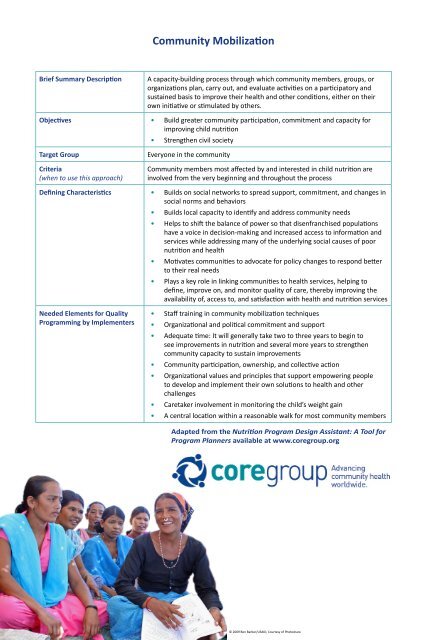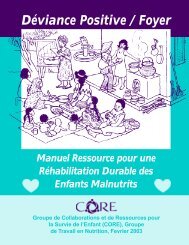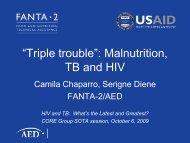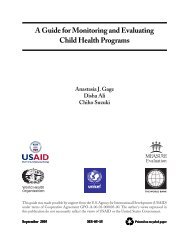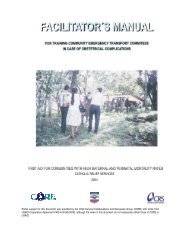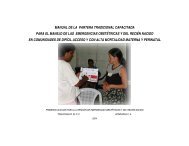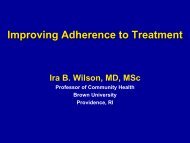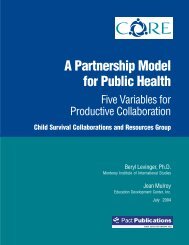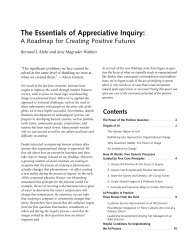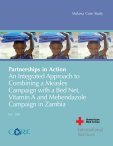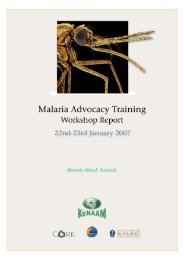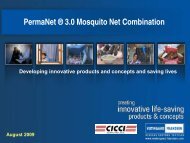Nutrition Program Design Assistant Posters - CORE Group
Nutrition Program Design Assistant Posters - CORE Group
Nutrition Program Design Assistant Posters - CORE Group
You also want an ePaper? Increase the reach of your titles
YUMPU automatically turns print PDFs into web optimized ePapers that Google loves.
Essential <strong>Nutrition</strong> Actions1.Promotion of optimal breastfeeding during the first six months2.Promotion of optimal complementary feeding starting at 6 monthswith continued breastfeeding to 2 years of age and beyond3.Promotion of optimal nutritional care of sick and severelymalnourished children4.Prevention of vitamin A deficiency in women and children5.Promotion of adequate intake of iron and folic acid and preventionand control of anemia for women and children6.Promotion of adequate intake of iodine by all members of thehousehold7.Promotion of optimal nutrition for womenAdapted from the <strong>Nutrition</strong> <strong>Program</strong> <strong>Design</strong> <strong>Assistant</strong>: A Tool for <strong>Program</strong> Plannersavailable at www.coregroup.org© 2008 Marily Knieriemen/ Helen Keller International, Courtesy of Photoshare
Home Visits (e.g., Auxiliary Nurses, CHWs, Care <strong>Group</strong>s)Brief Summary DescriptionHome visits, conducted by CHWs, auxiliary nurses, or specialized communityCNVs, provide an opportunity for one-on-one, personalized counseling,outreach, follow-up and support to pregnant women, lactating women,caregivers of children and their families. Visits may include checking on thehealth of a baby, counseling caregivers, or following up with a child who hasexperienced growth faltering, acute malnutrition, and/or illness.Objectives • Ensure child’s health or growth is improving• Improve care and feeding practices• Support familyTarget <strong>Group</strong>sCriteria(when to use this approach)Defining CharacteristicsNeeded Elements for Quality<strong>Program</strong>ming by Implementers• Pregnant and lactating women• Mothers/caregivers of children 0-23 or up to 59 months• Willing and available volunteers• Community where homes are located a short distance of each other• Opportunity to tailor messages to individual needs and to engage indialogue to negotiate change• Community members provide support and counseling• Individually tailored guidance and support• Counseling materials developed through formative research, appropriatefor a low-literate population, if necessary• Training on counseling and negotiation skills• Continuous supportive supervision• Caretaker involvement in monitoring the child’s weight gain• A central location within a reasonable walk for most community membersAdapted from the <strong>Nutrition</strong> <strong>Program</strong> <strong>Design</strong> <strong>Assistant</strong>: A Tool for<strong>Program</strong> Planners available at www.coregroup.orgSave the Children
Community-Based Growth Monitoring and Promotion (CBGMP)Brief Summary DescriptionApproach implemented at the community level to prevent undernutritionand improve child growth through monthly monitoring of child weight gain(although there is growing consensus that monitoring height/length gain maybe more critical), one-on-one counseling and negotiation for behavior change,home visits, and integration with other health services. Action is taken based onwhether a child has gained adequate weight, not by a nutritional status cutoffpoint, and then identifying and addressing growth problems before the childbecomes malnourished. A major benefit of high-quality programs includes thatcaregivers witness their child’s weight gain and thereby receive reinforcementfor improving their practices. Additionally, CBGMP provides an opportunity foradvocacy with community leaders and other persons of influence to becomeinvolved in seeking local solutions to the problem of growth faltering andundernutrition.Objectives • Improve child growth• Prevent undernutrition• Early detection of growth faltering and undernutritionTarget <strong>Group</strong>Criteria(when to use this approach)Children 0-23 monthsBest used in communities with high prevalence of mild or moderateunderweight or stuntingDefining Characteristics • Creates community motivation/sensitization to reduce underweight• Uses trained community-selected volunteers• Uses “inadequate weight gain” as early indicator of growth faltering• Referral and counter-referral system with health posts/centers• Uses counseling and negotiation specific to the individual child• Home visits• Active community involvement in problem solving and planning• Potential contact for MUAC and edema screening and SAM referral• Addresses many causes of poor growth, not just the symptoms, and isclosely tied to promoting evidence-based interventionsNeeded Elements for Quality<strong>Program</strong>ming by ImplementersFor the individual child:• Routine monthly assessment of growth status• Feedback on growth and on assessment of health and feeding• Individualized counseling on feeding and child care practices andnegotiating adoption of improved practices• Follow-up and referral following program standardsAcross the whole program:• Quality counseling• Analysis of causes of inadequate growth with guidelines for taking actions• A large network of community-based workers or volunteers (two to threecommunity workers per 20 children) to be effective• Supportive and quality monitoring and supervision• Community participation in planningAdapted from the <strong>Nutrition</strong> <strong>Program</strong> <strong>Design</strong> <strong>Assistant</strong>: A Tool for<strong>Program</strong> Planners available at www.coregroup.orgSave the Children
Food Supplementation/Food Assistance: PreventionBrief Summary DescriptionObjectiveIn food-insecure environments, programs may choose to supplement the dietsof women, children, and/or households to help them meet their macro andmicronutrient needs. Food supplements may be in the form of internationalfood aid, including fortified blended foods and vitamin A-fortified oil, or locallyor regionally purchased foods. The food rations are generally distributedon a monthly basis. To be most effective, food supplementation should beaccompanied by essential health and nutrition services and SBC programming.One food supplementation program, the Preventing Malnutrition in ChildrenUnder 2 Approach (PM2A), is a specific, tested package of actions aimed atpreventing undernutrition. Although PM2A has been found to be more effectivein reducing chronic malnutrition than recuperative programs, it may not beappropriate in all program contexts. There is also a great deal of experiencewith the use of food supplementation to meet gaps in the diet in emergencysituations; some lessons are applicable in developing contexts.Reduce prevalence of chronic malnutritionTarget <strong>Group</strong>s • All children 6-23 months of age• Pregnant women• Lactating women from delivery until the child is 6 months of age• Households of the participant women and childrenCriteria(when to use this approach)Defining CharacteristicsNeeded Elements for Quality<strong>Program</strong>ming by Implementers• Food-insecure environment• Evidence that the area can absorb the quantity of food supplementationneeded and that the food supplementation will not displace local foodproduction. (Bellmon Estimation for Title II is a resource for this)• Logistical capacity for transport, storage, and management of foodcommodity• Health services available (or ability to work to strengthen health services)• Levels of child stunting and/or underweight are high (>30% or 20%,respectively)• Food is provided to vulnerable people who could not otherwise access it• Opportunity to link with agriculture and livelihood sectors and improvefood access while also improving utilization• Food supplementation may also be targeted on a seasonal basis, when thefood needs are the greatest• Provision of or access to basic essential health services• Complementary SBC programming focused on maternal nutrition, IYCF,hygiene, and health-seeking behaviors• Close coordination with health, nutrition, and food security programs andservices• Formative research to adapt program to local conditions, including aseasonal calendar of when food needs are greatest• Caretaker involvement in monitoring the child’s weight gain• A central location within a reasonable walk for most community membersAdapted from the <strong>Nutrition</strong> <strong>Program</strong> <strong>Design</strong> <strong>Assistant</strong>: A Tool for<strong>Program</strong> Planners available at www.coregroup.orgR. Santos/International Relief & Development


